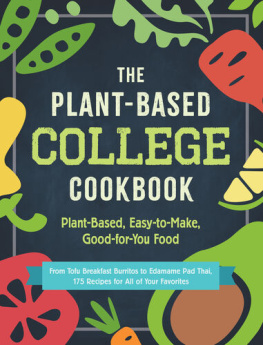
Try-It Diet: Gluten-Free
A two-week healthy eating plan
Adams Media, an imprint of Simon & Schuster, Inc.

Avon, Massachusetts
Contents
Introduction
A Try-It Diet is just that a diet that you can try out for two weeks to see if it is a good fit for you. Keep in mind that not every diet is right for every person; please consult with your doctor before making radical changes to your diet.
Is a gluten-free diet important for your lifestyle? If you have a food allergy or the autoimmune disorder known as celiac disease, it may be important for you to take charge of your life and begin a new food regimen.
About 1 in 133 people suffer from celiac disease, and health organizations say 2 percent to 2.5 percent of the general population suffer from food allergy or between 6 million and 7 million Americans. The difference between food allergy and celiac disease is that the latter, also known as celiac sprue, is an autoimmune disorder, like diabetes.
Unlike other autoimmune diseases, however, physicians know the trigger for celiac disease: gluten, which provokes an immune response that causes the body to attack itself.
Celiac disease is an intestinal disorder caused by the intolerance of some individuals to gluten, a protein in wheat, rye, barley, and some other grains. Gluten irritates the intestinal lining, interfering with the absorption of nutrients and water. Unlike certain food allergies, celiac disease is not grown out of, and those with the disease must maintain constant vigilance to keep their diet gluten-free. Untreated, the disease can lead to severe complications and potential long-term illness. The disease is permanent, and damage to the small intestine will occur every time gluten is consumed, regardless of whether symptoms are present. Reactions among people who suffer from this disease vary, but they are inevitable. The only treatment is strict adherence to a 100 percent gluten-free diet.
Maintaining a healthy gluten-free lifestyle involves eating a well-balanced, gluten-free diet that is high protein and normal in fats. Common nutrient shortages among people with celiac disease include deficiencies in calcium; the vitamin B complex; and vitamins A, C, D, K, and E. It is important for the celiac to eat a carefully balanced diet to ensure that he or she is getting all the vitamins the body needs.
The gluten-free diet involves totally eliminating the ingestion of all items containing the proteins found in wheat, rye, barley, and the many related grains. Before you turn to a gluten-free diet, make sure you see your physician and determine if eliminating gluten is right for you. Starting the diet without complete testing is not recommended and makes diagnosis later more difficult.
Once youve made the decision to be gluten-free, you can purchase ingredients at natural food stores, online, and at some grocery stores. Fresh fruits, meats, and veggies are a great place to start always remember, if they are fresh, they are gluten-free. If the food is manufactured or prepared, chances are it is not. In building a gluten-free diet plan, remove wheat grain products, including the obvious breads, cakes, and cookies and the not so obvious, among them, products with wheat starch or other gluten-containing grain derivatives.
Even with the gluten-free food sections available in stores, shopping can be a hassle. You must still read every label very carefully. Preparing meals can take a lot of effort, especially at first. By eating fresh foods, stocking up on the right ingredients, absorbing basic information, and building up your recipe file, you can start benefiting from a gluten-free diet in as soon as one day, or in up to six weeks. Supplements like echinacea, to boost the immune system; garlic, which is an antibacterial; vitamin C; and Chinese herbs can also be useful in helping you live a healthy life.
Dont feel deprived gluten-free food is as delicious as any other. For example, food fried in deep fat the southern way has no wheat flour its made with corn flour and/or cornmeal. Dip meat, chicken, veggies, and shrimp in corn flour and egg, then in cornmeal, and youve got a crunchy, delicious deep-fried meal.
A trip to an ethnic grocery store may open up many new sources of delicious meals. Corn flour, found in Latin American groceries, works well. Risotto, a staple in Italian cooking, is a delicious alternative to pasta. Try flour substitutes in traditional recipes.
We found that despite a good pasta-making machine, commercial gluten-free pasta is much more sensible than homemade. So try one of the excellent gluten-free pastas available from your health or Asian food store and online retailers.
Remember, experimentation is part of the process, so dont get discouraged. When you start cooking, you may not get it right the first time. Keep trying until you do get it right.
Be creative. Vary ingredients and quantities and follow the recipes in this book for success. Bon appetit!
If youd like to explore the Gluten-Free Diet in more detail, check out The Everything Gluten-Free Diet Book , available in print (ISBN: 978-1593373948) and eBook (eISBN: 978-1-4405-2339-7) formats.
Weekly Meal Plans
Week 1
Sunday
Breakfast
Lunch
Snack
Dinner
Monday
Breakfast
Lunch
Snack
Dinner
Tuesday
Breakfast
Lunch
Snack
Dinner
Wednesday
Breakfast
Lunch
Snack
Medium-sized orange and cup walnuts
Dinner
Thursday
Breakfast
Lunch
Snack
Dinner
Friday
Breakfast
Lunch
Snack
Dinner
Saturday
Breakfast
Lunch
Snack
Dinner
Week 2
Sunday
Breakfast
Lunch
Snack
Dinner
Monday
Breakfast
Lunch
Snack
Dinner
Tuesday
Breakfast
Lunch
Snack
Dinner
Wednesday
Breakfast
Lunch
Snack
Small apple and cup almonds
Dinner
Thursday
Breakfast
Lunch
Snack
Dinner
Friday
Breakfast
Lunch
Snack
Banana and cup pistachios
Dinner
Saturday
Breakfast
Lunch
Snack
Dinner
Ricotta Griddlecakes
Preparing the batter in your blender makes it velvety smooth. You can serve with fruit, or dress with a berry coulis. The ricotta adds protein.
Next page




















